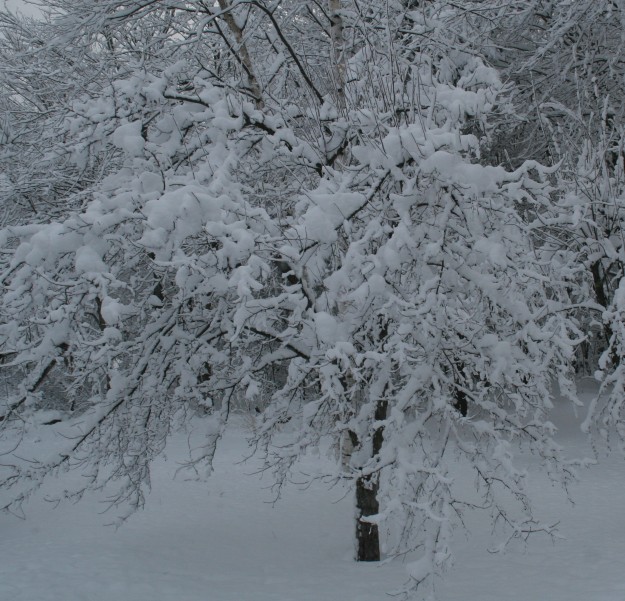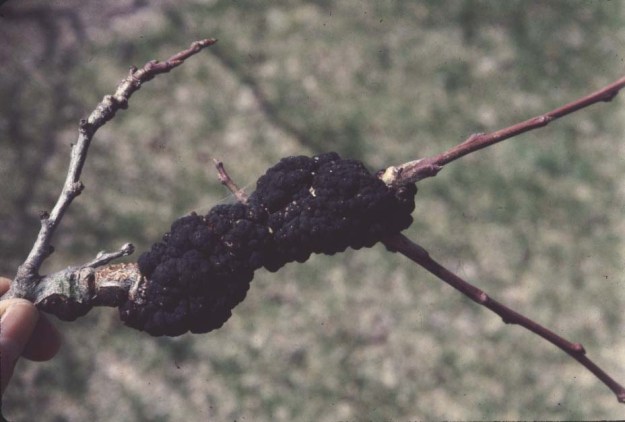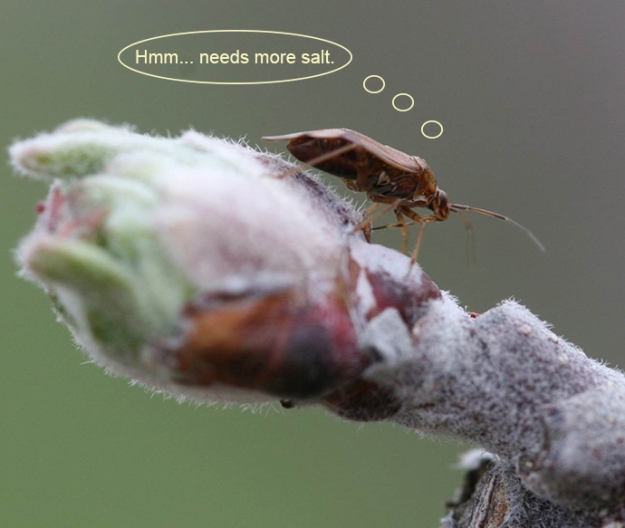How did Fruit Pests, Parasites Predators Survive This Cold Winter?
The answer varies, according to where and how each species overwinters, and its tolerance for cold. Some insects and mites overwinter on the twigs, so they are fully exposed to the prolonged cold temperatures, and also to the brief extremes, like a couple of hours at minus 12F one morning. European red mite eggs and apple aphid eggs have almost no protection, so I’m expecting lower than usual survival rate for them. Egg masses of eastern tent caterpillar are also exposed on twigs, but they have a protective covering. They might do a little better.
Our predaceous mite Typhlodromus pyri overwinters under scales of bark on the trunk, close to the ground level. That’s where the temperatures are coldest. Some may have gotten protection from deep snow, but overall I’m anticipating that they will not survive well, and may take time to recover this summer.
Tentiform leafminers (and their parasites), trumpet leafminers, and apple scab fungus overwinter in last year’s dead leaves. Since they have been covered by an insulating layer of snow most of the winter, they should have been pretty well protected from the extremes, and I expect them to survive at close to their usual rates. I think tarnished plant bug falls in this category too.
Some are really well protected, and I anticipate normal survival. Plum curculio is in this category. It burrows under the leaf litter in woods. Apple maggot and blueberry fruit fly survive as pupae in the soil, so they are very well protected.
Unknown: we still do not understand just where spotted wing drosophila overwinter. We think they do so as adults, and probably in woodland, but no one knows yet. I cannot guess how well they will do. With such a high reproductive rate, and time for 10 or more generations per year in southern NH, I think SWD could recover quickly if overwinter survival was poor. So it might be possible that we would see lower than usual numbers in July, if overwinter survival was poor. But it could recover by August.
New Hampshire SWD Crop Losses
In December and January, Becky Sideman, George Hamilton and I set up another online damage survey for SWD. We did the first such survey in December 2012, and learned from that that NH crop losses were $1.516 million that year. Wow! This time, we made some slight modifications in the survey tool, but overall sought the same information. The survey was open for about 7 weeks, and then we crunched the numbers. We learned that 2013 NH SWD crop losses were down by almost two thirds. The total loss figure was $526,000. The SWD catch was pretty comparable between the two years, with the catch beginning and peaking about 1 week later in 2013, compared to 2012.
There are plenty of people to thank for helping achieve this $987,000 drop in damage. On the survey, several growers thanked UNH Cooperative Extension, and it was gratifying to read the results. We really did work hard to help you. But we also benefitted from significant collaborations with extension and research colleagues in other states, and grant funding from USDA-NIFA and the NH Department of Agriculture, Markets and Food. And of course, the people who listened, read, and changed their behavior to successfully control this pest were… you, the growers. You can read more details on the losses at the SWD page of UNH Cooperative Extension’s website.
Deer are Hungry Now
Deer are really hungry now, and as the deep crusty snow melts, they gain access to more feeding sites. Be sure those fences are up and gates are closed, especially at night. After I pruned my two apple trees, I picked up all of the prunings and carried them far away from the trees. Early the next morning, I saw that the prunings had been heavily hit by deer.
San Jose Scale
Were you one of the growers with San Jose scale on apples at harvest time? If so, you might consider a change or two to this year’s management plan for the affected block(s). One is to be sure that affected trees are pretty well pruned. We often see SJS gain a foothold in trees that get poor spray coverage, and canopy density is a factor. Another is to consider a spray to affected trees at the half-inch green stage. Options include superior oil, Lorsban, Supracide, Esteem plus oil, or Centaur. Excellent coverage is required to get good control. To me, a better timing of a SJS spray is when the crawlers have emerged. That will occur in June. You can optimize the timing by installing a maximum/minimum thermometer in the affected block, and checking it daily, starting at bloom. You’ll be figuring out degree days. I’ll have more details later. Do you use solid tree guards, like the wrap-around plastic strips? If so, consider replacing them with something that allows sprays to penetrate and reach the trunk. The worst SJS infestation I ever saw was on several young trees with wrap-around spiral “mouse” guards. When we unwrapped the guards, there were hundreds (possibly thousands) of scales living on the bark underneath, where the insecticides could not reach. In this case, all that was needed to correct the problem was to remove the guards. Normal spraying did the rest.
Pruning and Pest Management
Pruning can help lessen pest problems, in several ways. One obvious one is to reduce the density of the tree or bush canopy. Very dense canopies are difficult for sprays to penetrate, so we can see an increase of problems from San Jose scale, oystershell scale and other pests in poorly pruned crops. Adults of spotted wing drosophila really like dense canopies. Dense canopy also lengthens foliage drying time. Apple scab, black rot, brown rot and many other fungal diseases can be worse in plants with dense canopies, partly because of lengthened drying time and partly from lack of fungicide penetration.
Pruning can physically remove pests or inoculum sources. Good examples are black knot lesions on stone fruit (photo), and fireblight cankers on pome fruit. If you remove and burn black knot cankers from plums and cherries, you’re not only removing potential inoculum to spread infections, but you are also likely eliminating lesser peach tree borers, too. They really like to bore into the “knots”. David Rosenberger reminded me that sometimes a lone, tall wild black cherry tree at the edge of a stone fruit block can have a black knot gall or two that is high up, and can easily spread infection into the susceptible trees. If you can’t reach the galls and cut them out, then maybe cutting down the tree would be a good idea. If this is beside an apple block, black knot galls would not pose a threat, and actually the tree is a source of parasites that attack our leafminers in apples.
Tent caterpillar egg masses are not common on trees sprayed with synthetic insecticides, but they are very common on backyard or organic apple trees (photo). They are shiny, dark brown, and encircle the twig. If you remove them before they hatch in early April, you won’t have problems from that pest this year. Do your gloves turn orange when pruning apple trees? If so, that suggests that you’ve encountered lots of European red mite eggs. I need a hand lens to see them… round dull red eggs, 0.15mm across, clustered near the buds.
If you prune off lesions or eggs, do you have to destroy or haul them away, or is dropping them on the ground good enough? The answer varies. In New Hampshire, dropping mummified stone fruit to the ground is good enough. The spores of brown rot fungus can’t get airborne. But south of New England, it would be better to remove them from the orchard and burn or bury them. (Different types of spores survive down there.) To me, black knot lesions and tent caterpillar masses are things I’d prefer to see burned, rather than just dropped on the ground. Fireblight cankers? Get them out of the orchard, and burn or deeply bury. If they are small diameter, this isn’t as critical (they dry out more quickly.). Thicker diameter branches: more important to burn/bury.
I prefer to remove prunings from the orchard right away if possible, if deer have access. Otherwise I’d be inviting them to concentrate and feed there. Many orchardists now wait until the ground is relatively firm, and then run a tractor-pulled chopper over the prunings. Having picked up prunings by hand and piled them onto trucks, I can understand the attraction to chop the stuff.
Apple Grain Aphids — Don’t Spray!
Apparently spring will eventually come. When it does, and apple buds begin to open and show exposed green tissue, several pest events occur. One such event is that we see clusters of small, dark aphids on some opening buds. Almost all of them are apple grain aphids. These are on opening apple buds for a very short time, and do not cause a problem. Soon they move to other plants in the orchard. The “problem” to me is that some growers see them and immediately apply an insecticide, which is a waste of money, kills insect predators and parasites, and needlessly exposes the applicator to toxicity.
Tarnished Plant Bug
I’m expecting to see TPB’s at almost their usual population levels this spring, but I’ll be happy if the population is lower. They feed on fruit tree buds on mild, sunny days, especially if the snow cover has melted. Two or three days of sunny weather with temperatures in 50’s or 60’s really brings them out. As usual, orchards with lots of vetch, alfalfa or clover nearby typically have much higher TPB pressure than those with few such plants. Buds that are attacked by TPB usually ooze liquid for a few days. I find them in apple and peach orchards more than in other orchard trees. Maybe that’s just because those are our most abundant species of fruit trees.
Is it worth spraying? You could answer that question yourself, by hanging several white sticky TPB traps in the edge rows of your orchard at silver tip stage. Hang them at knee height, near the branch tips, over a grassy part of the orchard floor. Then check them weekly and count up the number of TPB’s that you find. For apple growers with a good market for #1 fruit (like PYO blocks), a cumulative catch of 5 TPB’s caught per trap from silver tip to tight cluster makes it worthwhile to spray. If you haven’t reached threshold by tight cluster stage, you could wait and look again at pink. An average of 8 or more per trap by pink would warrant control. For people who aim to sell extra fancy apples, the thresholds are a cumulative catch of 3 and 5 per trap. I am relieved to note that many apple growers don’t bother to spray for TPB any longer. I think that is a good trend!
2014 New England Tree Fruit Management Guide
We still print this guide, with Cornell University doing the printing. There are relatively few printed, so the cost is relatively high. This year, they cost us a few cents under $36 each, so we are charging $36 per copy. We are not really set up to mail them out, so I plan to bring copies to meetings, and hopefully reach those who need them. If you are off the beaten path and would like one, let me know, and we’ll see if we can figure out how to get one to you. Once our copies are sold, the only way to get one would be to contact extension fruit staff in another New England state, & see if they have any left.
Alan T. Eaton, Extension Specialist, Integrated Pest Management
UNH Cooperative Extension programs and policies are consistent with pertinent Federal and State laws and regulations, and prohibits discrimination in its programs, activities and employment on the basis of race, color, national origin, gender, religion, age, disability, political beliefs, sex, sexual orientation, or veteran’s, marital or family status. New Hampshire counties cooperating.






